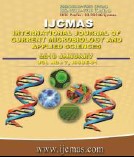


 National Academy of Agricultural Sciences (NAAS)
National Academy of Agricultural Sciences (NAAS)

|
PRINT ISSN : 2319-7692
Online ISSN : 2319-7706 Issues : 12 per year Publisher : Excellent Publishers Email : editorijcmas@gmail.com / submit@ijcmas.com Editor-in-chief: Dr.M.Prakash Index Copernicus ICV 2018: 95.39 NAAS RATING 2020: 5.38 |
The development of the agriculture is primarily the application of the science and technology by making the best use of available resources; one of the major constraints of traditionally rice growing varieties is low productivity due to non-adoption of recommended package of practices and improves varieties. Krishi Vigyan Kendra, Deoria under ICAR- Indian Institute of Vegetable Research had conducted Front Line Demonstration (FLD) in adopted farmer fields. Cultivation practices comprised under FLD viz. improved varieties, seed treatment, spacing, balance use of fertilizers, intercultural operations and plant protection measures showed increase in yield of rice from 1.05% to 51.90% over local check. Technology gap was lowest 130 kg/ha and highest 1090 kg/ha was observed. The extension gap in Pusa Sugandha 2511 was higher (1683 kg/ha) as compared to technology gap. Technology index was highest 24.22% in Pusa 519 followed by Pusa 44 (24.0%) and Pusa Sungandha 2511 (14.36%). The lower the value of the technology index indicates the more feasibility of the technology.
 |
 |
 |
 |
 |